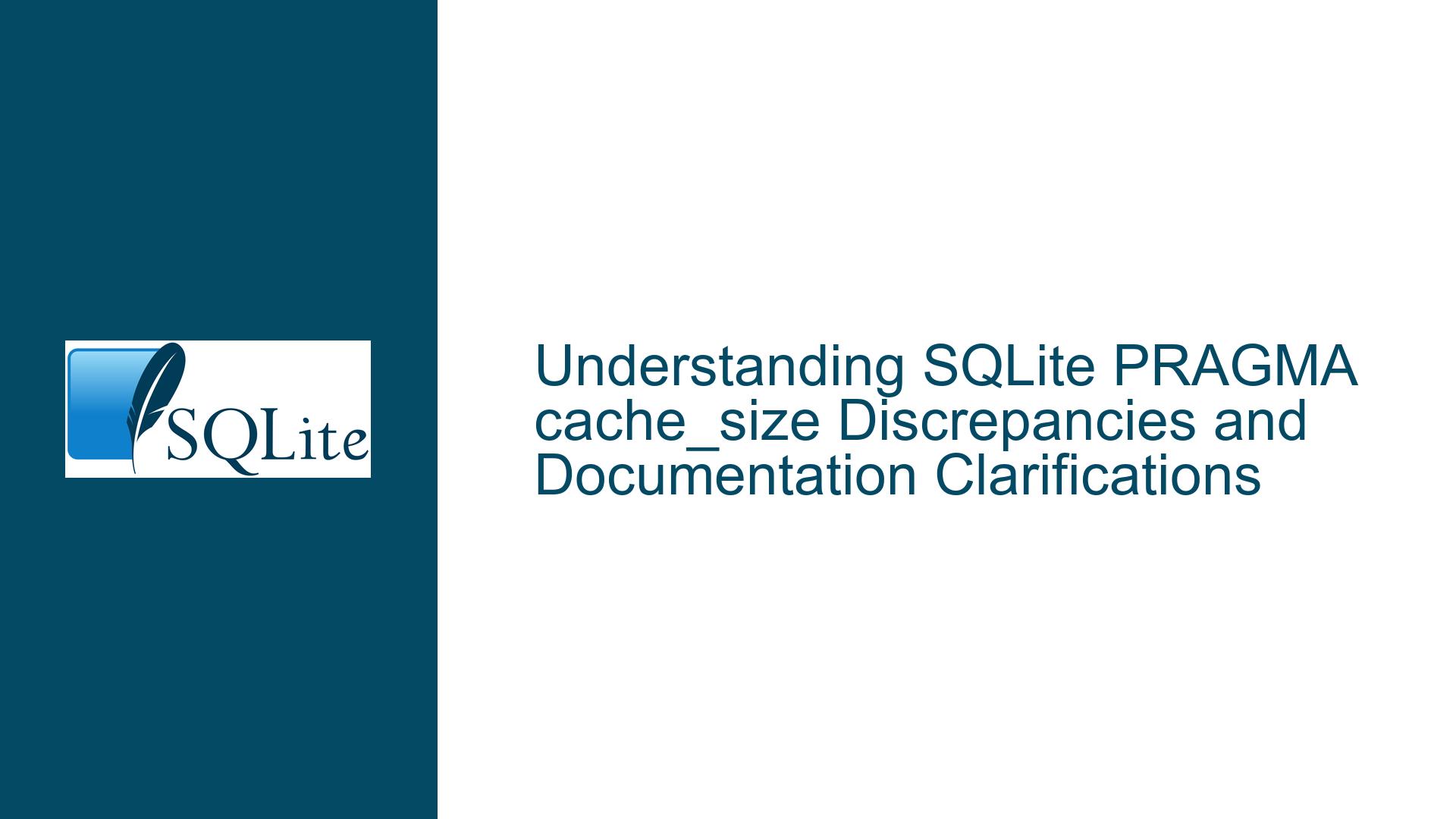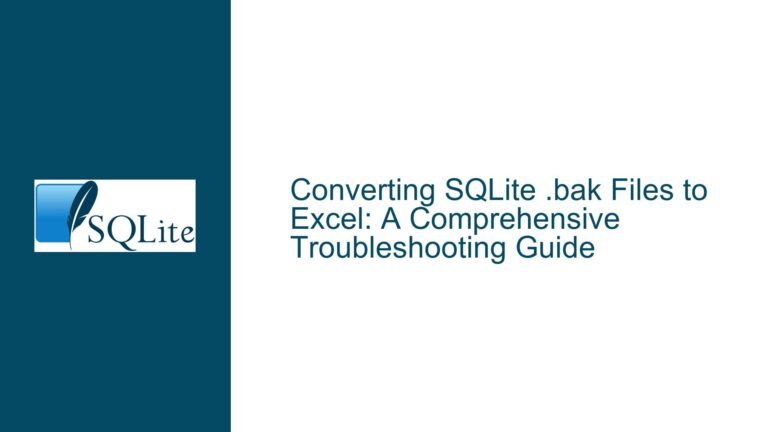SQLite PRAGMA cache_size Discrepancies and Documentation Clarifications
Issue Overview: Conflicting Cache Size Values and Documentation Ambiguities
The SQLite PRAGMA schema.cache_size directive governs the maximum number of database pages held in memory by the pager cache. Its behavior hinges on whether the assigned value is positive (page count) or negative (memory budget in kibibytes). However, discrepancies arise between documented defaults, observed runtime values, and interpretations of page size dependencies. A user reported that the default cache_size returned 2000 instead of the documented -2000, with further confusion about whether negative values reference a legacy page size (1024 bytes) or the current page size (often 4096 bytes). This raises three critical questions:
Why does the default
cache_sizediffer between SQLite builds?
The observed2000vs.-2000suggests compile-time customization or page size adjustments.How do negative
cache_sizevalues interact with page size changes?
The documentation states negative values compute pages asabs(N)*1024bytes, but modern page sizes (post-3.12.0) default to 4096 bytes, creating ambiguity.Are the
cache_sizepragma syntax examples accurate?
The distinction betweenPRAGMA cache_size = pages(positive) andPRAGMA cache_size = -kibibytes(negative) requires validation against SQLite’s internal logic.
Possible Causes: Compilation Settings, Page Size Evolution, and Unit Misinterpretations
Cause 1: Nonstandard Compile-Time Defaults
SQLite allows custom builds to override default pragma values. If a distribution (e.g., macOS’s system sqlite3) sets -DSQLITE_DEFAULT_CACHE_SIZE=2000 during compilation, the default cache_size becomes 2000 instead of -2000. This explains why the user observed 2000 on macOS but -2000 in standard builds. Compile-time overrides bypass the documented behavior, prioritizing distribution-specific optimizations.
Cause 2: Legacy vs. Current Page Size Assumptions
Prior to SQLite 3.12.0 (2016), the default page size was 1024 bytes. Negative cache_size values were designed to approximate memory usage using this legacy size: abs(N)*1024 bytes. However, the default page size changed to 4096 bytes in 3.12.0, while the documentation retained the 1024 multiplier. This creates confusion: does PRAGMA cache_size = -2000 allocate 2000*1024 bytes (legacy) or 2000*4096 bytes (current)? The documentation’s reference to 1024 is outdated but intentional—it preserves backward compatibility for applications relying on kibibyte calculations irrespective of page size.
Cause 3: Misunderstanding Negative Value Semantics
Negative cache_size values specify a memory budget in kibibytes (1024 bytes), not page-count equivalents. For example, PRAGMA cache_size = -2000 configures the cache to use approximately 2000*1024 = 2,048,000 bytes, divided by the current page size to determine the page count. If the page size is 4096 bytes, this becomes 2,048,000 / 4096 = 500 pages. Thus, negative values abstract away page size specifics, while positive values directly set the page count. Misinterpreting negative values as page-size-agnostic leads to incorrect memory estimates.
Troubleshooting Steps, Solutions & Fixes: Aligning Practice with Documentation
Step 1: Verify SQLite Build Configuration
Command:
sqlite3 :memory: 'PRAGMA compile_options;'
Analysis:
Check for SQLITE_DEFAULT_CACHE_SIZE in the output. If present, the default cache_size was overridden at compile time. For example, macOS’s system SQLite might set this to 2000, altering the default from -2000. Recompile SQLite without this option to restore documented behavior.
Step 2: Correlate Page Size and Cache Size
Commands:
PRAGMA page_size; -- Check current page size (e.g., 4096)
PRAGMA cache_size = -2000;
PRAGMA cache_size; -- Returns 2000*1024 / page_size
Example Calculation:
If page_size is 4096, -2000 sets cache_size to (2000 * 1024) / 4096 = 500. Executing PRAGMA cache_size; returns 500, not -2000. To achieve a 2000-page cache with a 4096-byte page size, use PRAGMA cache_size = 2000.
Step 3: Adjust Cache Size Dynamically
Use Case:
An application requiring a 100MB cache with a 4096-byte page size:
PRAGMA cache_size = -102400; -- 102400 KiB = 100 MiB
PRAGMA cache_size; -- Returns 102400*1024 / 4096 = 25600 pages
Recommendation:
Prefer negative values for memory budgeting, as they automatically adjust to page size changes (e.g., VACUUM resets page size). Positive values fix the page count, risking memory overallocation if the page size increases.
Step 4: Update Documentation Understanding
Clarifications:
- The
1024multiplier incache_sizedocumentation refers to kibibytes, not the legacy page size. Negative values always use1024bytes/KiB, regardless ofpage_size. - The default
-2000suggests2000 KiB ≈ 2 MBfor the pager cache, which becomes2000*1024 / page_sizepages.
Revised Documentation Proposal:
If the argument N is positive, the cache holds exactly N pages. If N is negative, the cache size is adjusted to use approximately
abs(N)*1024bytes of memory, divided by the current page size. The default suggested cache size is-2000(2000 KiB).
Step 5: Handle Cross-Version Page Size Defaults
Scenario:
Migrating a pre-3.12.0 database (1024-byte pages) to a newer SQLite version (4096-byte pages).
Procedure:
- Pre-migration: Set
cache_sizeusing negative values to maintain memory budget:PRAGMA page_size = 4096; VACUUM; PRAGMA cache_size = -2000; -- Now allocates 500 pages (2000*1024 / 4096) - Post-migration: Re-evaluate cache performance. Larger pages may reduce the required page count for the same workload.
Step 6: Profile Cache Performance
Tool: Use sqlite3_analyzer or EXPLAIN QUERY PLAN to monitor cache efficiency.
Metrics:
- Page Cache Hits/Misses: A high miss rate indicates undersized cache.
- Memory Usage: Validate with
sqlite3_status(SQLITE_STATUS_PAGECACHE_USED, ...).
Adjustment Example:
-- Double the cache size if misses exceed 10%
PRAGMA cache_size = -4000;
Final Recommendations:
- For Distributors: Avoid overriding
SQLITE_DEFAULT_CACHE_SIZEunless necessary. Use negative values to respect user-configured page sizes. - For Developers: Prefer
PRAGMA cache_size = -kibibytesfor portable memory budgets. Explicitly setpage_sizeandcache_sizeduring database initialization. - For Documentation Maintainers: Clarify that
1024in negativecache_sizerefers to kibibytes, independent ofpage_size. Add examples contrasting legacy and modern page sizes.
By methodically aligning compile settings, page size assumptions, and documentation interpretation, users can resolve cache_size discrepancies and optimize SQLite’s memory management effectively.






